Exploring NbS Potential for Environmental Degradation in Bangladesh
VerifiedAdded on 2022/08/09
|24
|2049
|172
Project
AI Summary
This project investigates the potential and limitations of Nature-Based Solutions (NbS) in minimizing environmental degradation within the Chakaria sub-district, a coastal region of Bangladesh, focusing on the impact of human activities, loss of ecosystem services, and the failure of existing policies. The research aims to determine the effectiveness of NbS, integrated with effective environmental management policies and artificial infrastructure, in restoring ecosystem services, biodiversity, and reducing the adverse impacts of environmental degradation. The project includes an extensive literature review, explores the value of ecosystem services, and examines the challenges and opportunities in implementing NbS through a mixed-method research design involving exploratory research, surveys, key informant interviews, and GIS data analysis. The study hypothesizes that sustainable interventions using NbS will minimize and reverse ongoing environmental degradation, offering a promising approach to long-term sustainability, community participation, and the restoration of both environmental and human well-being within the vulnerable coastal ecosystem.
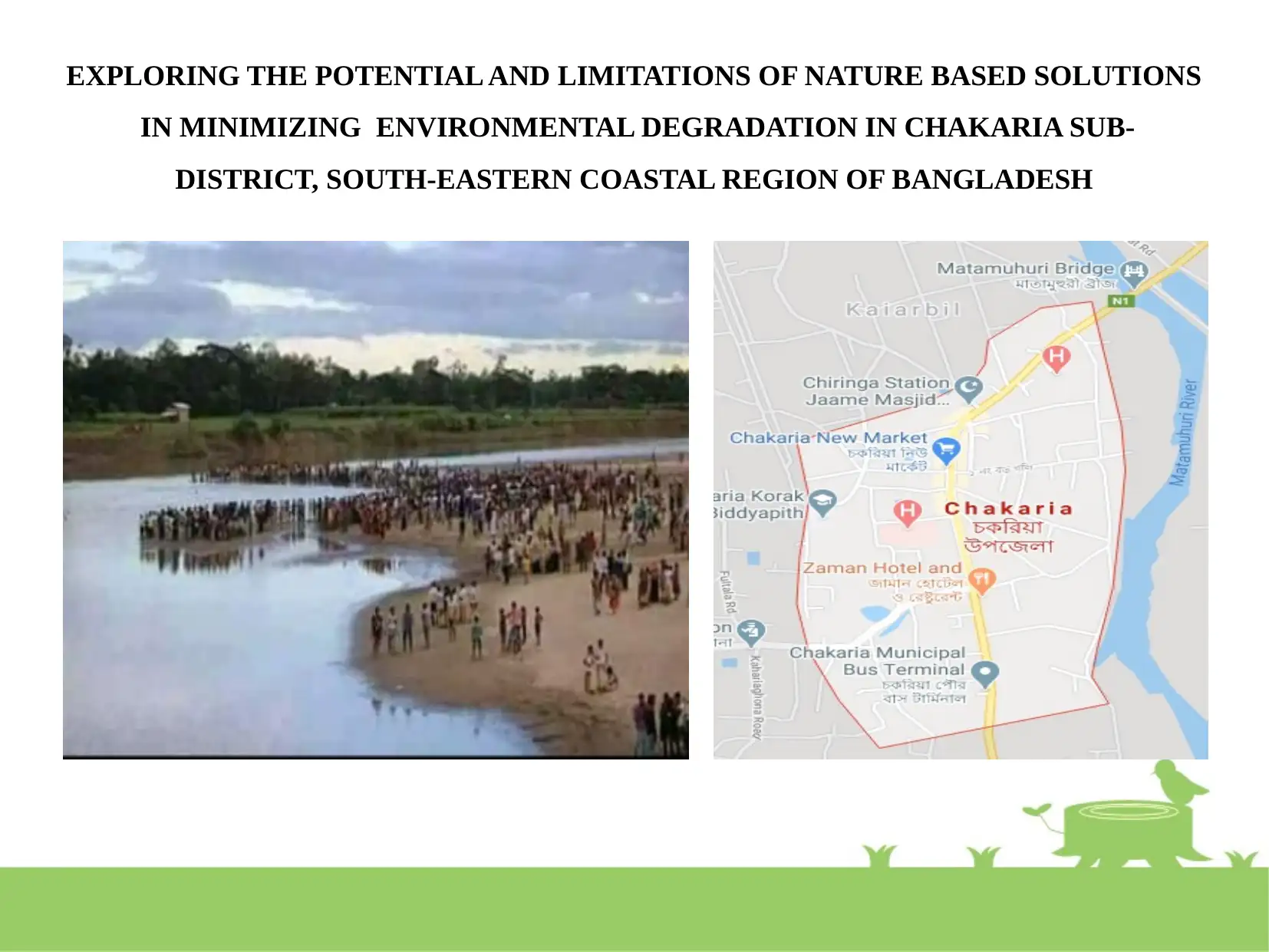
EXPLORING THE POTENTIAL AND LIMITATIONS OF NATURE BASED SOLUTIONS
IN MINIMIZING ENVIRONMENTAL DEGRADATION IN CHAKARIA SUB-
DISTRICT, SOUTH-EASTERN COASTAL REGION OF BANGLADESH
IN MINIMIZING ENVIRONMENTAL DEGRADATION IN CHAKARIA SUB-
DISTRICT, SOUTH-EASTERN COASTAL REGION OF BANGLADESH
Paraphrase This Document
Need a fresh take? Get an instant paraphrase of this document with our AI Paraphraser
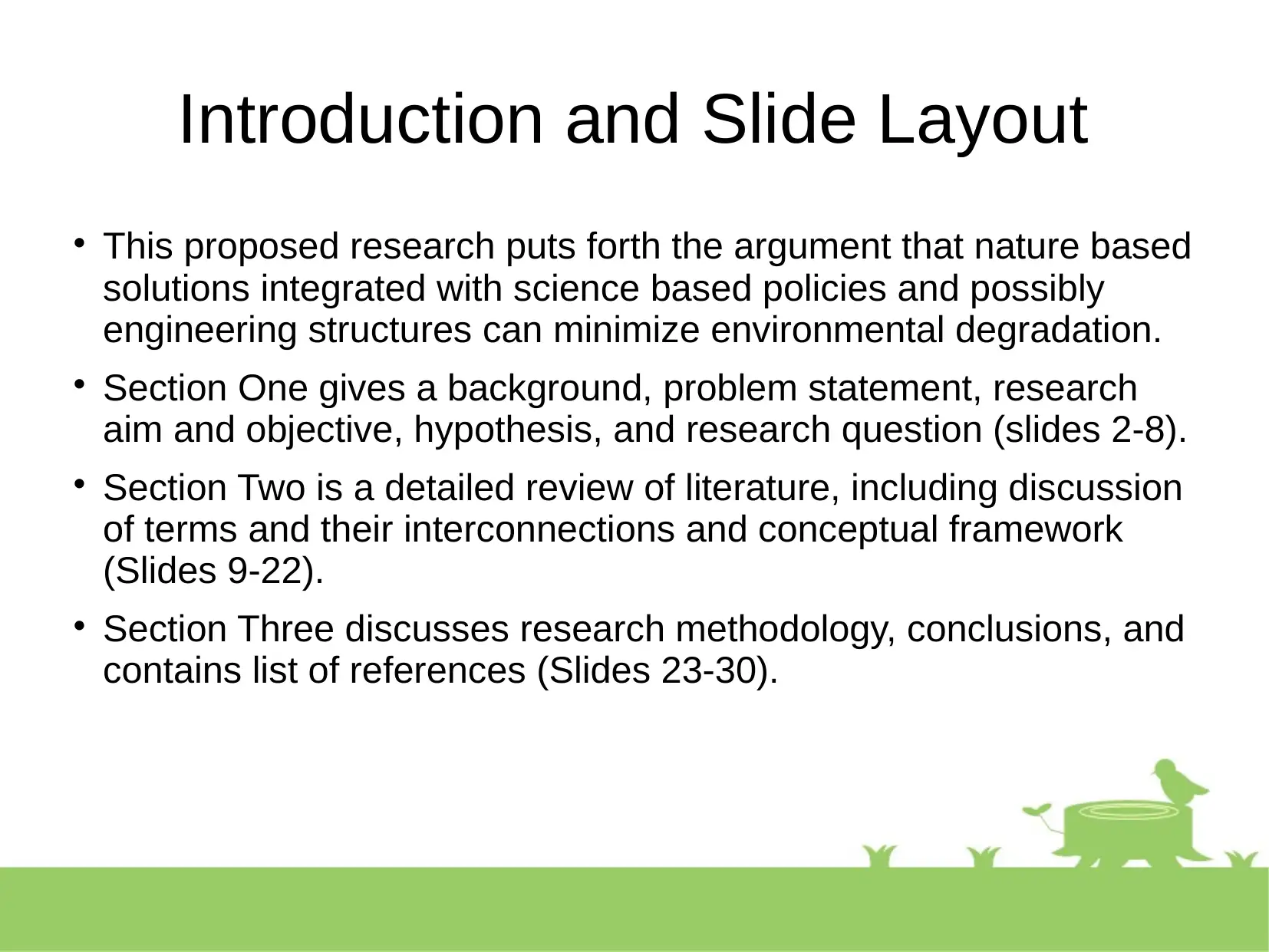
Introduction and Slide Layout
This proposed research puts forth the argument that nature based
solutions integrated with science based policies and possibly
engineering structures can minimize environmental degradation.
Section One gives a background, problem statement, research
aim and objective, hypothesis, and research question (slides 2-8).
Section Two is a detailed review of literature, including discussion
of terms and their interconnections and conceptual framework
(Slides 9-22).
Section Three discusses research methodology, conclusions, and
contains list of references (Slides 23-30).
This proposed research puts forth the argument that nature based
solutions integrated with science based policies and possibly
engineering structures can minimize environmental degradation.
Section One gives a background, problem statement, research
aim and objective, hypothesis, and research question (slides 2-8).
Section Two is a detailed review of literature, including discussion
of terms and their interconnections and conceptual framework
(Slides 9-22).
Section Three discusses research methodology, conclusions, and
contains list of references (Slides 23-30).
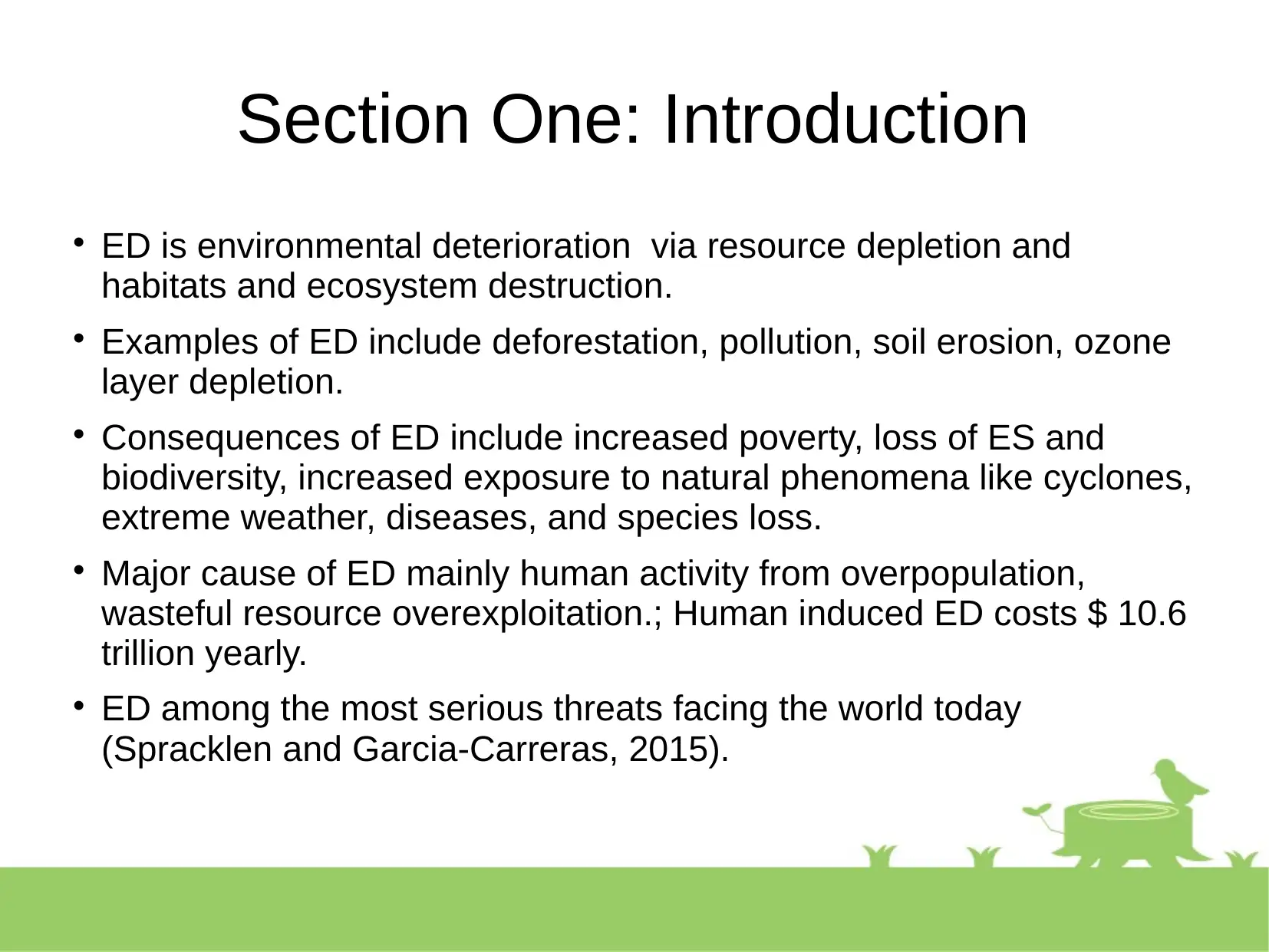
Section One: Introduction
ED is environmental deterioration via resource depletion and
habitats and ecosystem destruction.
Examples of ED include deforestation, pollution, soil erosion, ozone
layer depletion.
Consequences of ED include increased poverty, loss of ES and
biodiversity, increased exposure to natural phenomena like cyclones,
extreme weather, diseases, and species loss.
Major cause of ED mainly human activity from overpopulation,
wasteful resource overexploitation.; Human induced ED costs $ 10.6
trillion yearly.
ED among the most serious threats facing the world today
(Spracklen and Garcia-Carreras, 2015).
ED is environmental deterioration via resource depletion and
habitats and ecosystem destruction.
Examples of ED include deforestation, pollution, soil erosion, ozone
layer depletion.
Consequences of ED include increased poverty, loss of ES and
biodiversity, increased exposure to natural phenomena like cyclones,
extreme weather, diseases, and species loss.
Major cause of ED mainly human activity from overpopulation,
wasteful resource overexploitation.; Human induced ED costs $ 10.6
trillion yearly.
ED among the most serious threats facing the world today
(Spracklen and Garcia-Carreras, 2015).
⊘ This is a preview!⊘
Do you want full access?
Subscribe today to unlock all pages.

Trusted by 1+ million students worldwide
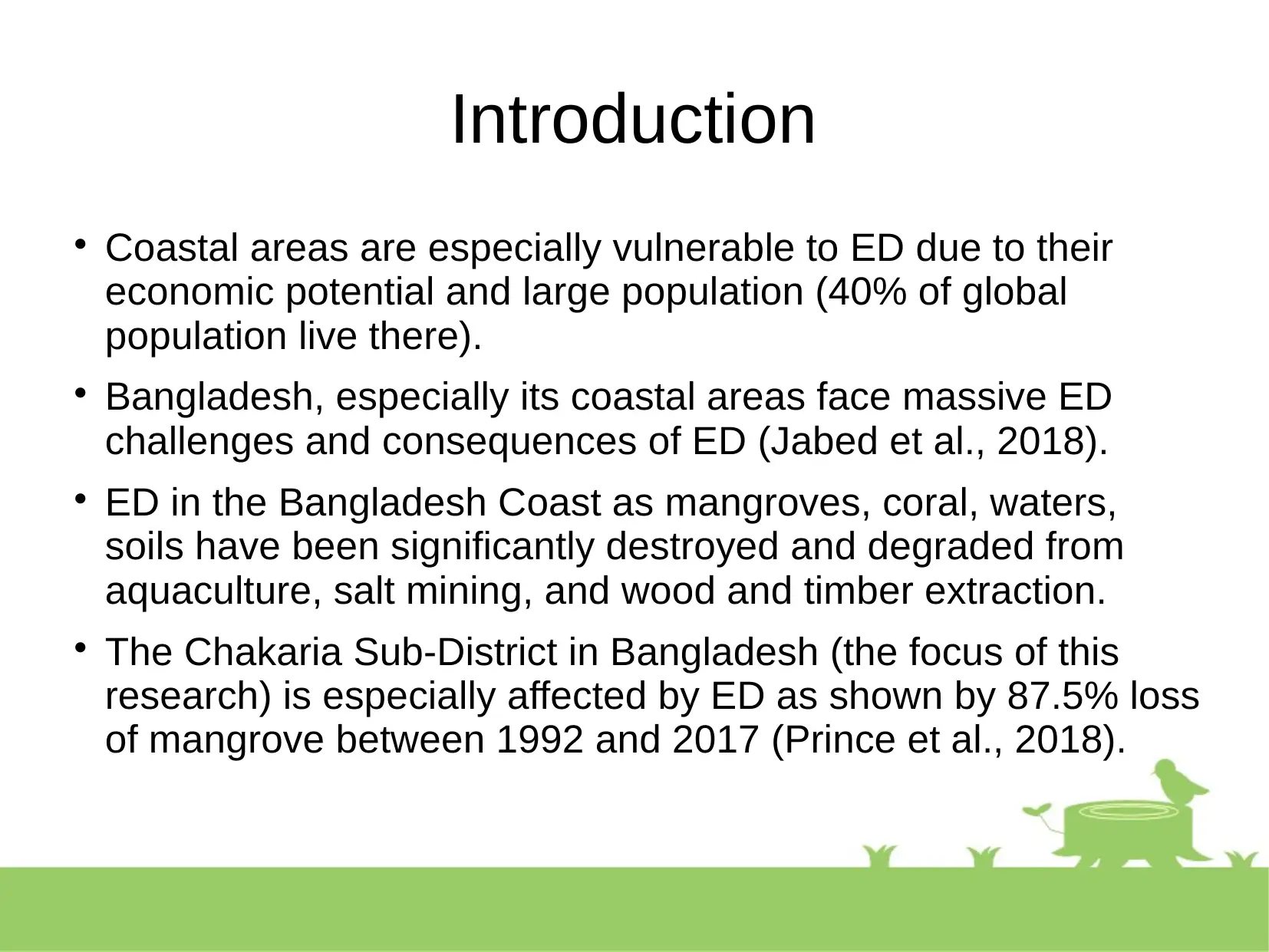
Introduction
Coastal areas are especially vulnerable to ED due to their
economic potential and large population (40% of global
population live there).
Bangladesh, especially its coastal areas face massive ED
challenges and consequences of ED (Jabed et al., 2018).
ED in the Bangladesh Coast as mangroves, coral, waters,
soils have been significantly destroyed and degraded from
aquaculture, salt mining, and wood and timber extraction.
The Chakaria Sub-District in Bangladesh (the focus of this
research) is especially affected by ED as shown by 87.5% loss
of mangrove between 1992 and 2017 (Prince et al., 2018).
Coastal areas are especially vulnerable to ED due to their
economic potential and large population (40% of global
population live there).
Bangladesh, especially its coastal areas face massive ED
challenges and consequences of ED (Jabed et al., 2018).
ED in the Bangladesh Coast as mangroves, coral, waters,
soils have been significantly destroyed and degraded from
aquaculture, salt mining, and wood and timber extraction.
The Chakaria Sub-District in Bangladesh (the focus of this
research) is especially affected by ED as shown by 87.5% loss
of mangrove between 1992 and 2017 (Prince et al., 2018).
Paraphrase This Document
Need a fresh take? Get an instant paraphrase of this document with our AI Paraphraser
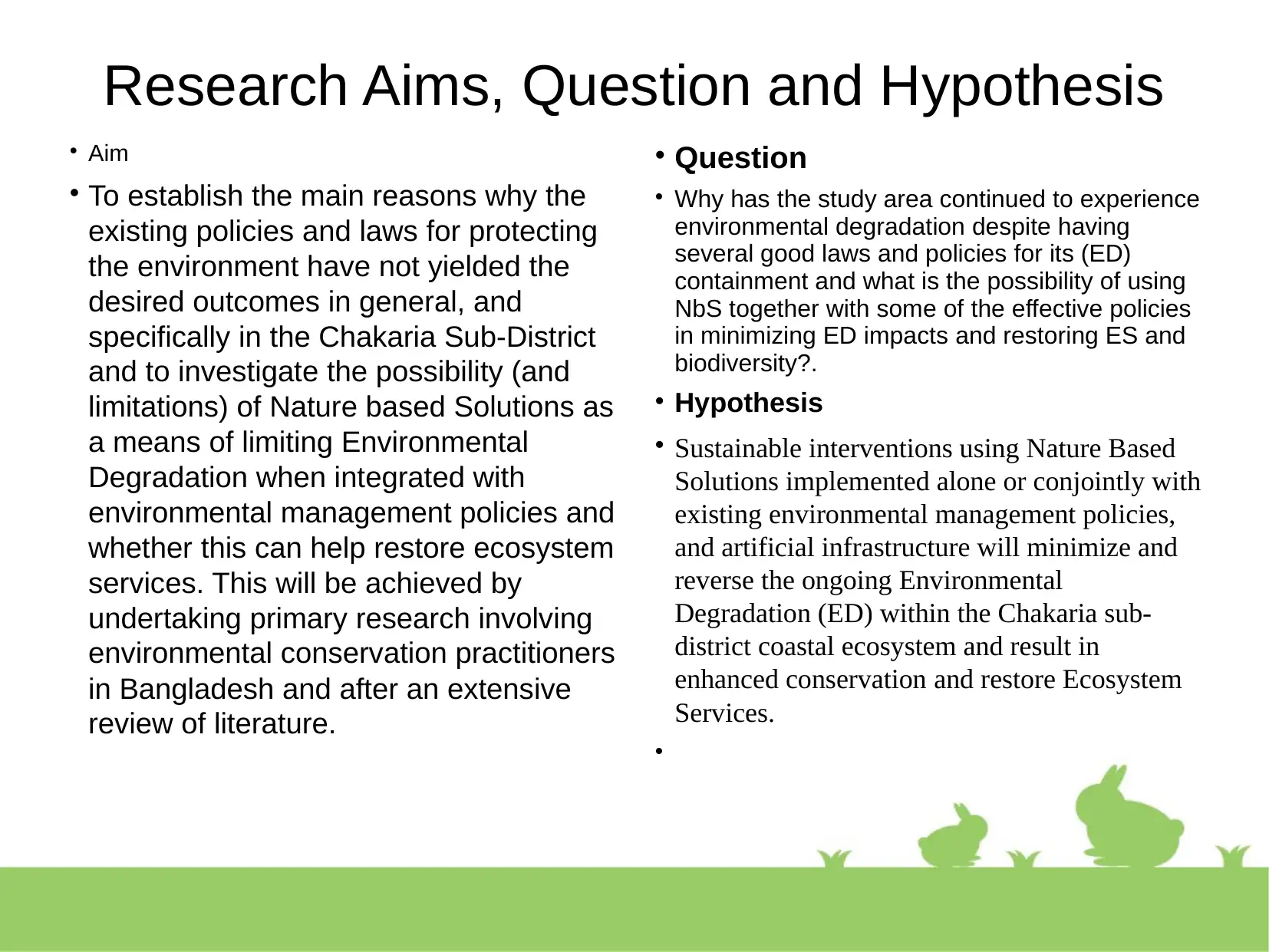
Research Aims, Question and Hypothesis
Aim
To establish the main reasons why the
existing policies and laws for protecting
the environment have not yielded the
desired outcomes in general, and
specifically in the Chakaria Sub-District
and to investigate the possibility (and
limitations) of Nature based Solutions as
a means of limiting Environmental
Degradation when integrated with
environmental management policies and
whether this can help restore ecosystem
services. This will be achieved by
undertaking primary research involving
environmental conservation practitioners
in Bangladesh and after an extensive
review of literature.
Question
Why has the study area continued to experience
environmental degradation despite having
several good laws and policies for its (ED)
containment and what is the possibility of using
NbS together with some of the effective policies
in minimizing ED impacts and restoring ES and
biodiversity?.
Hypothesis
Sustainable interventions using Nature Based
Solutions implemented alone or conjointly with
existing environmental management policies,
and artificial infrastructure will minimize and
reverse the ongoing Environmental
Degradation (ED) within the Chakaria sub-
district coastal ecosystem and result in
enhanced conservation and restore Ecosystem
Services.
Aim
To establish the main reasons why the
existing policies and laws for protecting
the environment have not yielded the
desired outcomes in general, and
specifically in the Chakaria Sub-District
and to investigate the possibility (and
limitations) of Nature based Solutions as
a means of limiting Environmental
Degradation when integrated with
environmental management policies and
whether this can help restore ecosystem
services. This will be achieved by
undertaking primary research involving
environmental conservation practitioners
in Bangladesh and after an extensive
review of literature.
Question
Why has the study area continued to experience
environmental degradation despite having
several good laws and policies for its (ED)
containment and what is the possibility of using
NbS together with some of the effective policies
in minimizing ED impacts and restoring ES and
biodiversity?.
Hypothesis
Sustainable interventions using Nature Based
Solutions implemented alone or conjointly with
existing environmental management policies,
and artificial infrastructure will minimize and
reverse the ongoing Environmental
Degradation (ED) within the Chakaria sub-
district coastal ecosystem and result in
enhanced conservation and restore Ecosystem
Services.
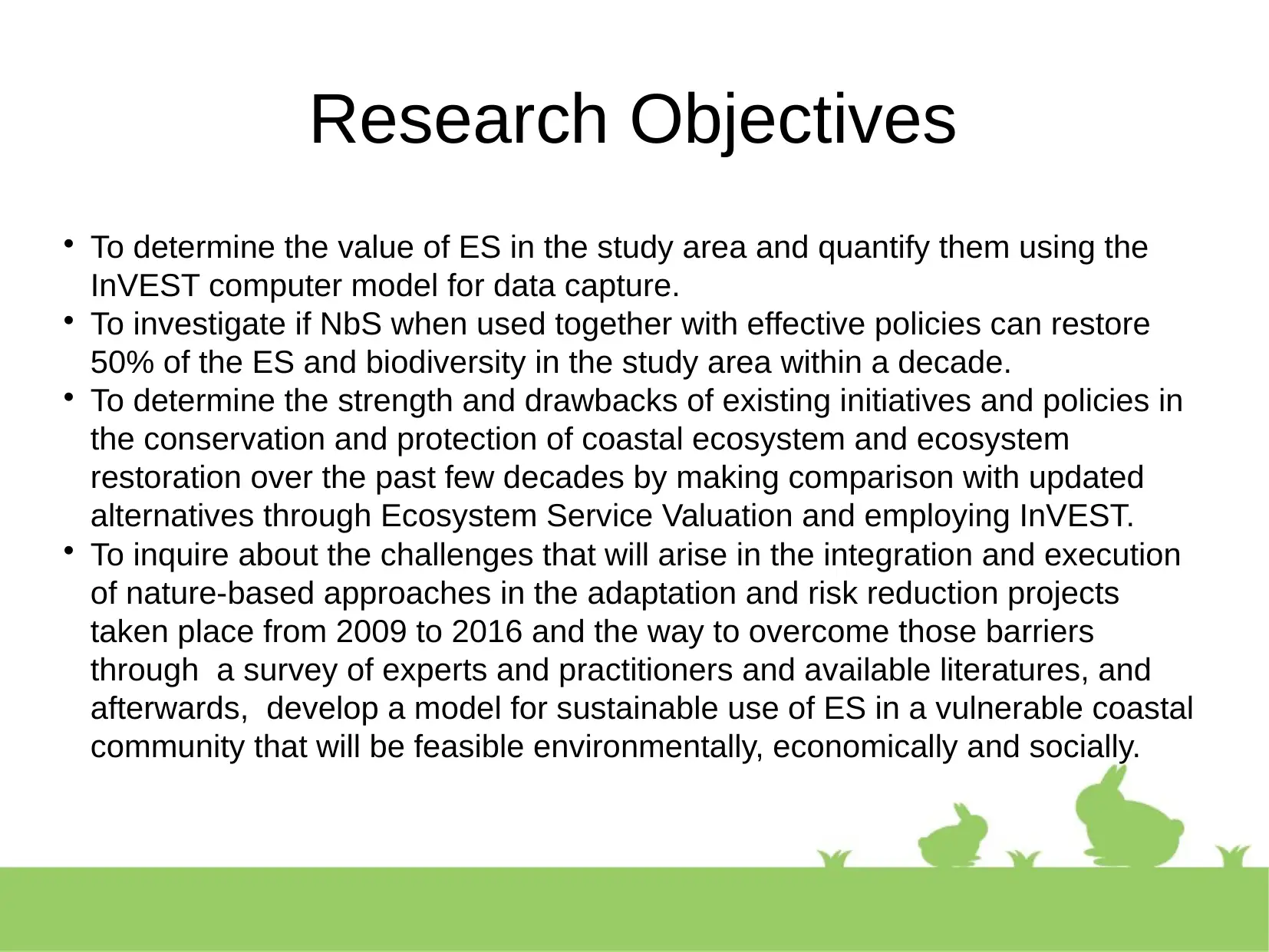
Research Objectives
To determine the value of ES in the study area and quantify them using the
InVEST computer model for data capture.
To investigate if NbS when used together with effective policies can restore
50% of the ES and biodiversity in the study area within a decade.
To determine the strength and drawbacks of existing initiatives and policies in
the conservation and protection of coastal ecosystem and ecosystem
restoration over the past few decades by making comparison with updated
alternatives through Ecosystem Service Valuation and employing InVEST.
To inquire about the challenges that will arise in the integration and execution
of nature-based approaches in the adaptation and risk reduction projects
taken place from 2009 to 2016 and the way to overcome those barriers
through a survey of experts and practitioners and available literatures, and
afterwards, develop a model for sustainable use of ES in a vulnerable coastal
community that will be feasible environmentally, economically and socially.
To determine the value of ES in the study area and quantify them using the
InVEST computer model for data capture.
To investigate if NbS when used together with effective policies can restore
50% of the ES and biodiversity in the study area within a decade.
To determine the strength and drawbacks of existing initiatives and policies in
the conservation and protection of coastal ecosystem and ecosystem
restoration over the past few decades by making comparison with updated
alternatives through Ecosystem Service Valuation and employing InVEST.
To inquire about the challenges that will arise in the integration and execution
of nature-based approaches in the adaptation and risk reduction projects
taken place from 2009 to 2016 and the way to overcome those barriers
through a survey of experts and practitioners and available literatures, and
afterwards, develop a model for sustainable use of ES in a vulnerable coastal
community that will be feasible environmentally, economically and socially.
⊘ This is a preview!⊘
Do you want full access?
Subscribe today to unlock all pages.

Trusted by 1+ million students worldwide
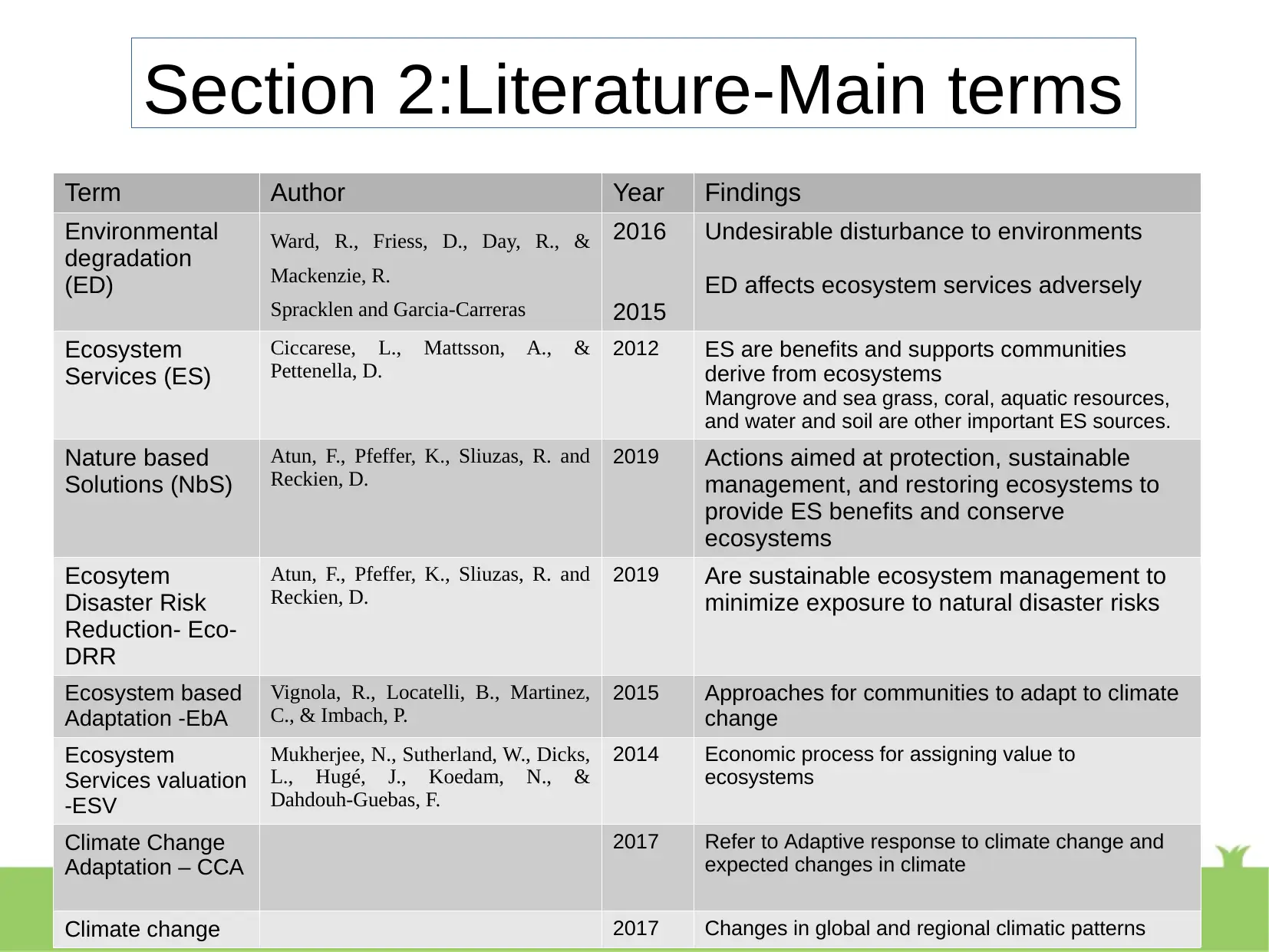
Section 2:Literature-Main terms
Term Author Year Findings
Environmental
degradation
(ED)
Ward, R., Friess, D., Day, R., &
Mackenzie, R.
Spracklen and Garcia-Carreras
2016
2015
Undesirable disturbance to environments
ED affects ecosystem services adversely
Ecosystem
Services (ES)
Ciccarese, L., Mattsson, A., &
Pettenella, D.
2012 ES are benefits and supports communities
derive from ecosystems
Mangrove and sea grass, coral, aquatic resources,
and water and soil are other important ES sources.
Nature based
Solutions (NbS)
Atun, F., Pfeffer, K., Sliuzas, R. and
Reckien, D.
2019 Actions aimed at protection, sustainable
management, and restoring ecosystems to
provide ES benefits and conserve
ecosystems
Ecosytem
Disaster Risk
Reduction- Eco-
DRR
Atun, F., Pfeffer, K., Sliuzas, R. and
Reckien, D.
2019 Are sustainable ecosystem management to
minimize exposure to natural disaster risks
Ecosystem based
Adaptation -EbA
Vignola, R., Locatelli, B., Martinez,
C., & Imbach, P.
2015 Approaches for communities to adapt to climate
change
Ecosystem
Services valuation
-ESV
Mukherjee, N., Sutherland, W., Dicks,
L., Hugé, J., Koedam, N., &
Dahdouh-Guebas, F.
2014 Economic process for assigning value to
ecosystems
Climate Change
Adaptation – CCA
2017 Refer to Adaptive response to climate change and
expected changes in climate
Climate change 2017 Changes in global and regional climatic patterns
Term Author Year Findings
Environmental
degradation
(ED)
Ward, R., Friess, D., Day, R., &
Mackenzie, R.
Spracklen and Garcia-Carreras
2016
2015
Undesirable disturbance to environments
ED affects ecosystem services adversely
Ecosystem
Services (ES)
Ciccarese, L., Mattsson, A., &
Pettenella, D.
2012 ES are benefits and supports communities
derive from ecosystems
Mangrove and sea grass, coral, aquatic resources,
and water and soil are other important ES sources.
Nature based
Solutions (NbS)
Atun, F., Pfeffer, K., Sliuzas, R. and
Reckien, D.
2019 Actions aimed at protection, sustainable
management, and restoring ecosystems to
provide ES benefits and conserve
ecosystems
Ecosytem
Disaster Risk
Reduction- Eco-
DRR
Atun, F., Pfeffer, K., Sliuzas, R. and
Reckien, D.
2019 Are sustainable ecosystem management to
minimize exposure to natural disaster risks
Ecosystem based
Adaptation -EbA
Vignola, R., Locatelli, B., Martinez,
C., & Imbach, P.
2015 Approaches for communities to adapt to climate
change
Ecosystem
Services valuation
-ESV
Mukherjee, N., Sutherland, W., Dicks,
L., Hugé, J., Koedam, N., &
Dahdouh-Guebas, F.
2014 Economic process for assigning value to
ecosystems
Climate Change
Adaptation – CCA
2017 Refer to Adaptive response to climate change and
expected changes in climate
Climate change 2017 Changes in global and regional climatic patterns
Paraphrase This Document
Need a fresh take? Get an instant paraphrase of this document with our AI Paraphraser
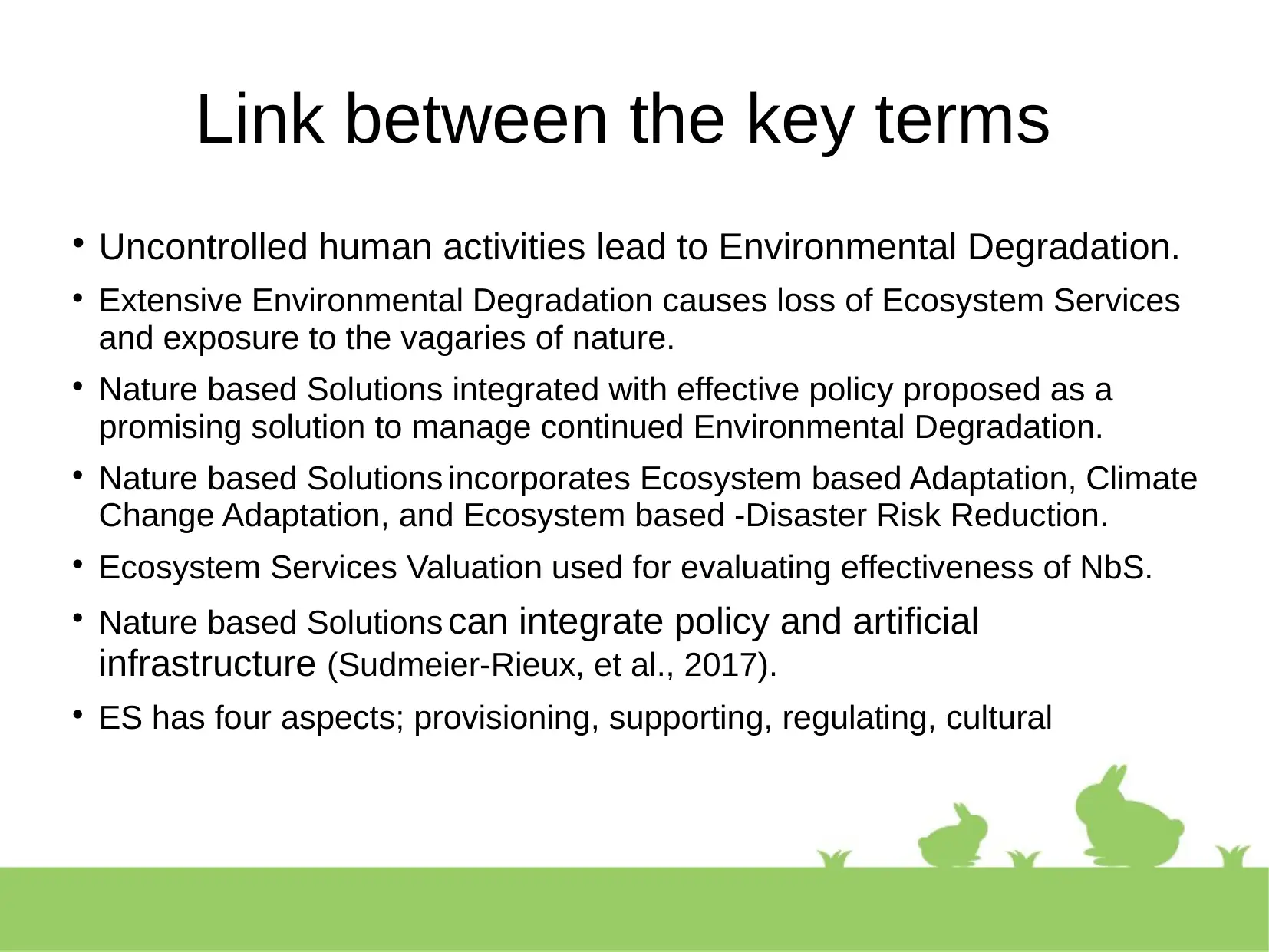
Link between the key terms
Uncontrolled human activities lead to Environmental Degradation.
Extensive Environmental Degradation causes loss of Ecosystem Services
and exposure to the vagaries of nature.
Nature based Solutions integrated with effective policy proposed as a
promising solution to manage continued Environmental Degradation.
Nature based Solutions incorporates Ecosystem based Adaptation, Climate
Change Adaptation, and Ecosystem based -Disaster Risk Reduction.
Ecosystem Services Valuation used for evaluating effectiveness of NbS.
Nature based Solutions can integrate policy and artificial
infrastructure (Sudmeier-Rieux, et al., 2017).
ES has four aspects; provisioning, supporting, regulating, cultural
Uncontrolled human activities lead to Environmental Degradation.
Extensive Environmental Degradation causes loss of Ecosystem Services
and exposure to the vagaries of nature.
Nature based Solutions integrated with effective policy proposed as a
promising solution to manage continued Environmental Degradation.
Nature based Solutions incorporates Ecosystem based Adaptation, Climate
Change Adaptation, and Ecosystem based -Disaster Risk Reduction.
Ecosystem Services Valuation used for evaluating effectiveness of NbS.
Nature based Solutions can integrate policy and artificial
infrastructure (Sudmeier-Rieux, et al., 2017).
ES has four aspects; provisioning, supporting, regulating, cultural
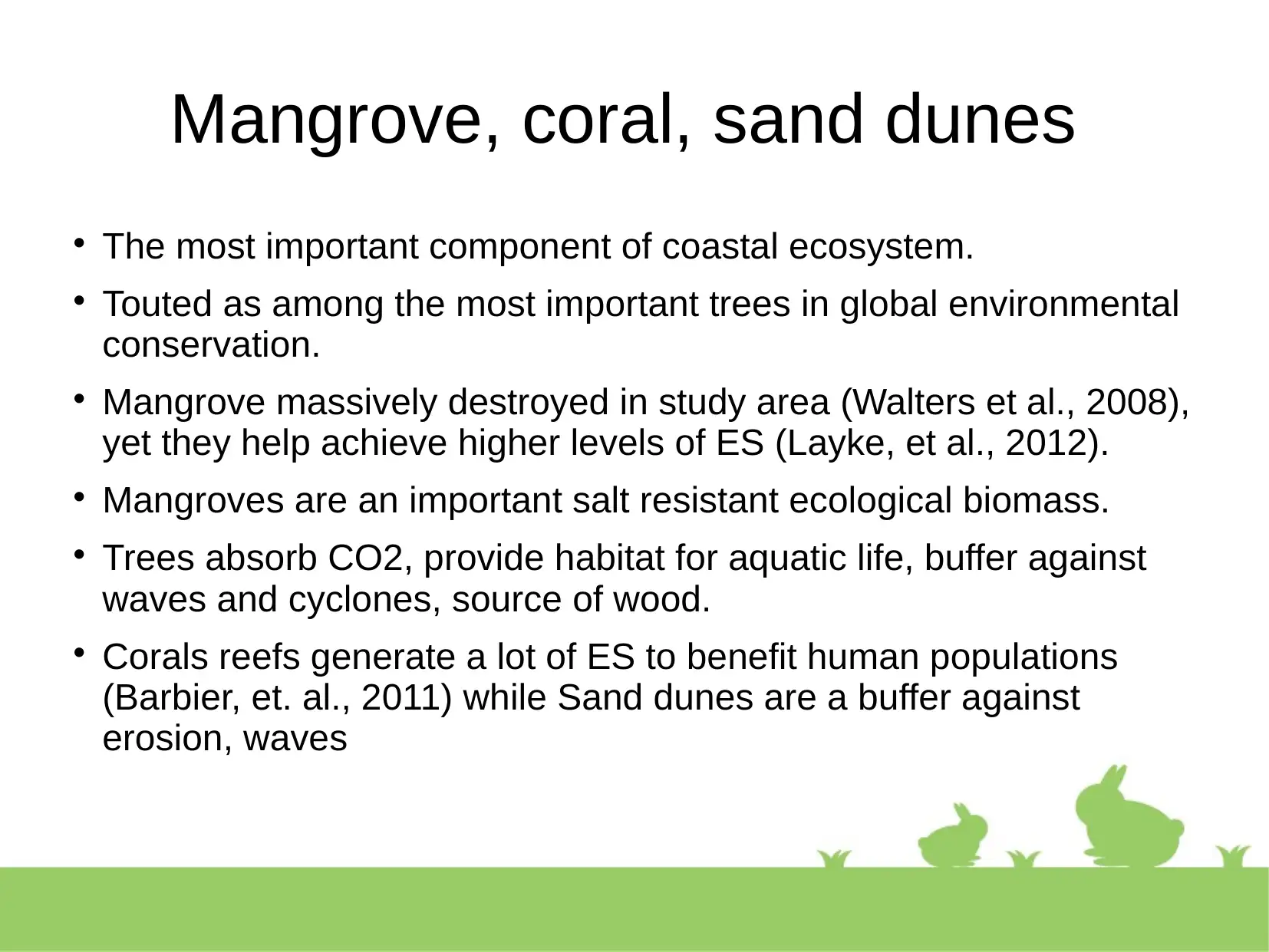
Mangrove, coral, sand dunes
The most important component of coastal ecosystem.
Touted as among the most important trees in global environmental
conservation.
Mangrove massively destroyed in study area (Walters et al., 2008),
yet they help achieve higher levels of ES (Layke, et al., 2012).
Mangroves are an important salt resistant ecological biomass.
Trees absorb CO2, provide habitat for aquatic life, buffer against
waves and cyclones, source of wood.
Corals reefs generate a lot of ES to benefit human populations
(Barbier, et. al., 2011) while Sand dunes are a buffer against
erosion, waves
The most important component of coastal ecosystem.
Touted as among the most important trees in global environmental
conservation.
Mangrove massively destroyed in study area (Walters et al., 2008),
yet they help achieve higher levels of ES (Layke, et al., 2012).
Mangroves are an important salt resistant ecological biomass.
Trees absorb CO2, provide habitat for aquatic life, buffer against
waves and cyclones, source of wood.
Corals reefs generate a lot of ES to benefit human populations
(Barbier, et. al., 2011) while Sand dunes are a buffer against
erosion, waves
⊘ This is a preview!⊘
Do you want full access?
Subscribe today to unlock all pages.

Trusted by 1+ million students worldwide
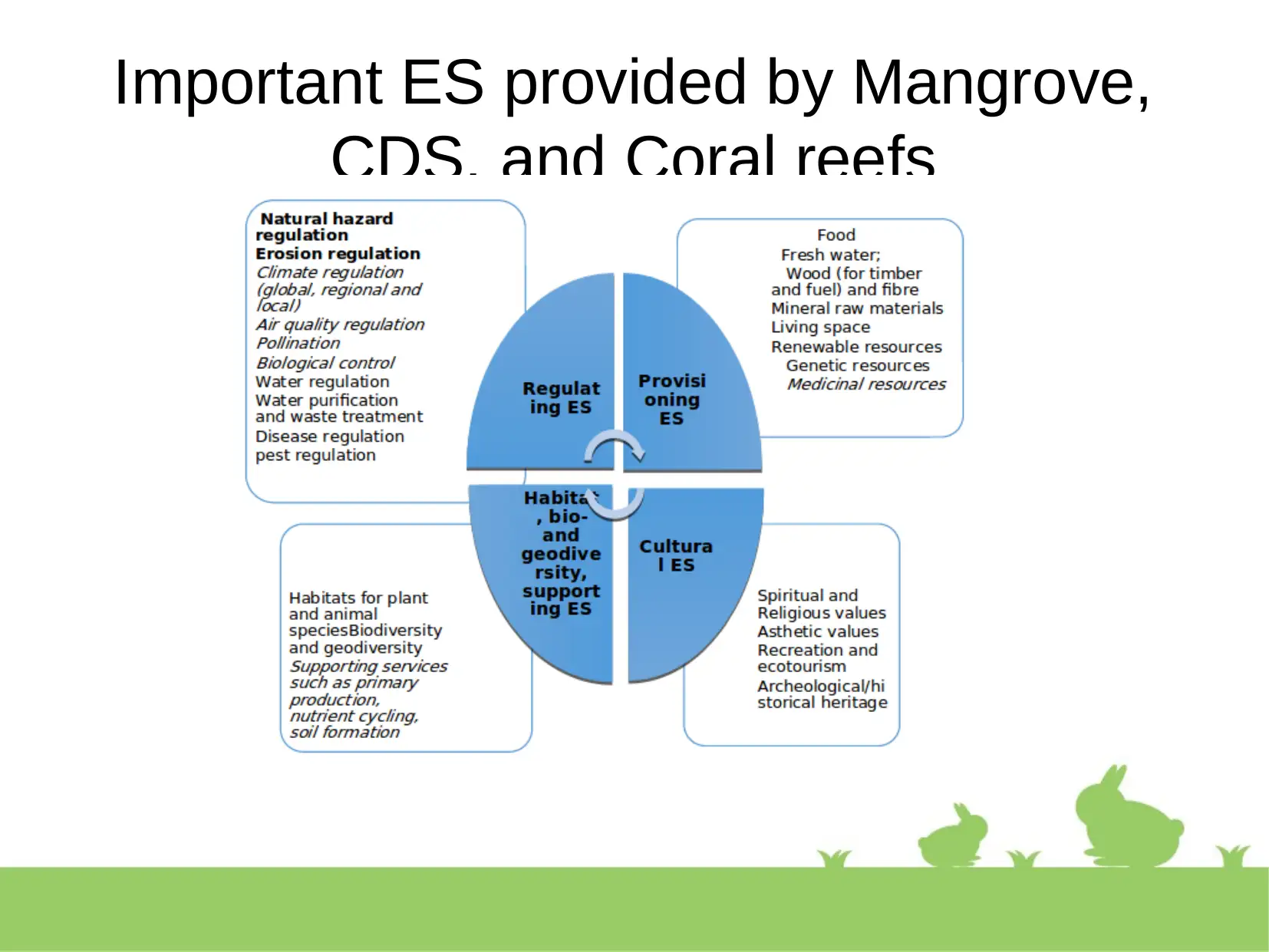
Important ES provided by Mangrove,
CDS, and Coral reefs
CDS, and Coral reefs
Paraphrase This Document
Need a fresh take? Get an instant paraphrase of this document with our AI Paraphraser
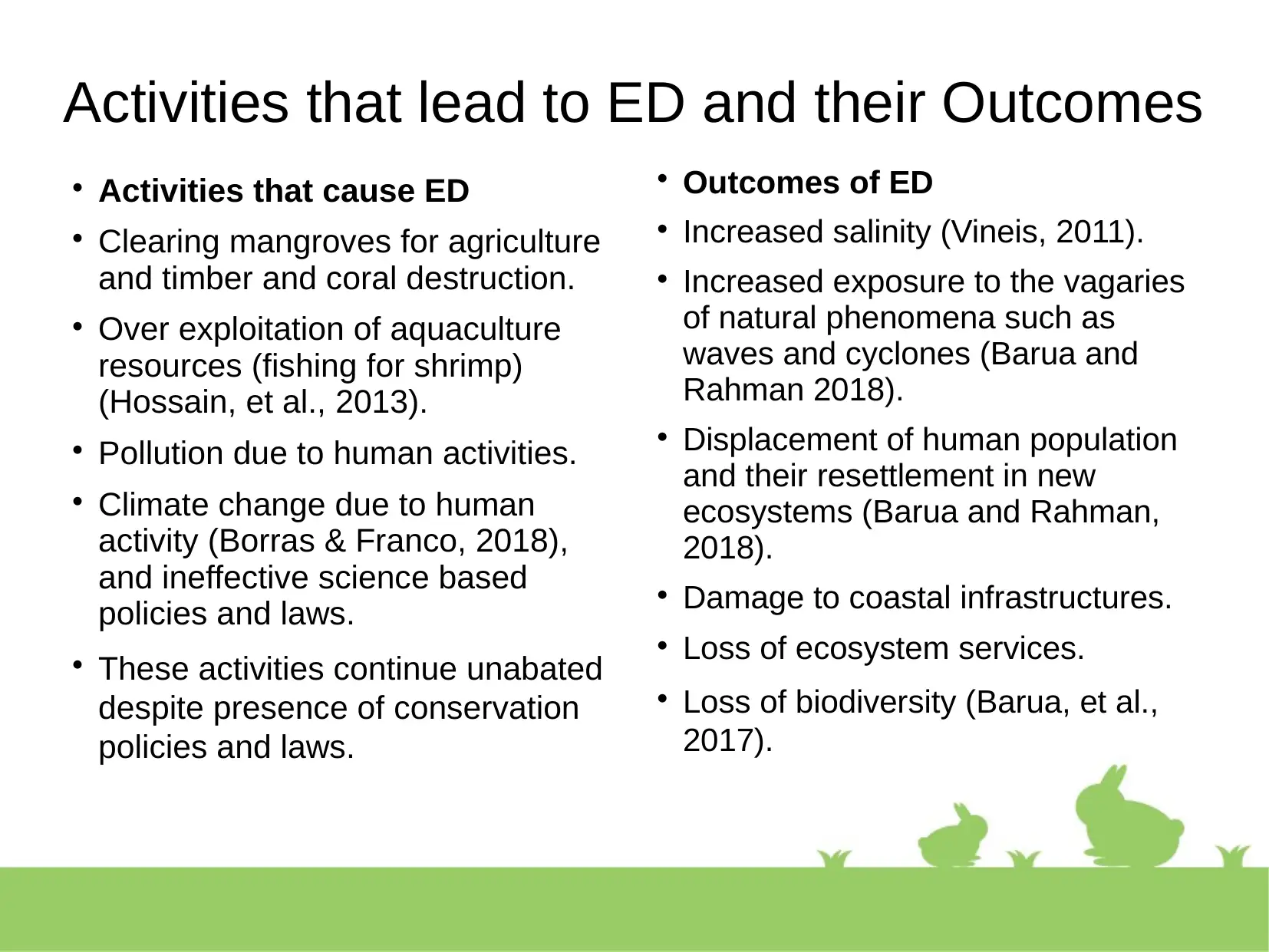
Activities that lead to ED and their Outcomes
Activities that cause ED
Clearing mangroves for agriculture
and timber and coral destruction.
Over exploitation of aquaculture
resources (fishing for shrimp)
(Hossain, et al., 2013).
Pollution due to human activities.
Climate change due to human
activity (Borras & Franco, 2018),
and ineffective science based
policies and laws.
These activities continue unabated
despite presence of conservation
policies and laws.
Outcomes of ED
Increased salinity (Vineis, 2011).
Increased exposure to the vagaries
of natural phenomena such as
waves and cyclones (Barua and
Rahman 2018).
Displacement of human population
and their resettlement in new
ecosystems (Barua and Rahman,
2018).
Damage to coastal infrastructures.
Loss of ecosystem services.
Loss of biodiversity (Barua, et al.,
2017).
Activities that cause ED
Clearing mangroves for agriculture
and timber and coral destruction.
Over exploitation of aquaculture
resources (fishing for shrimp)
(Hossain, et al., 2013).
Pollution due to human activities.
Climate change due to human
activity (Borras & Franco, 2018),
and ineffective science based
policies and laws.
These activities continue unabated
despite presence of conservation
policies and laws.
Outcomes of ED
Increased salinity (Vineis, 2011).
Increased exposure to the vagaries
of natural phenomena such as
waves and cyclones (Barua and
Rahman 2018).
Displacement of human population
and their resettlement in new
ecosystems (Barua and Rahman,
2018).
Damage to coastal infrastructures.
Loss of ecosystem services.
Loss of biodiversity (Barua, et al.,
2017).
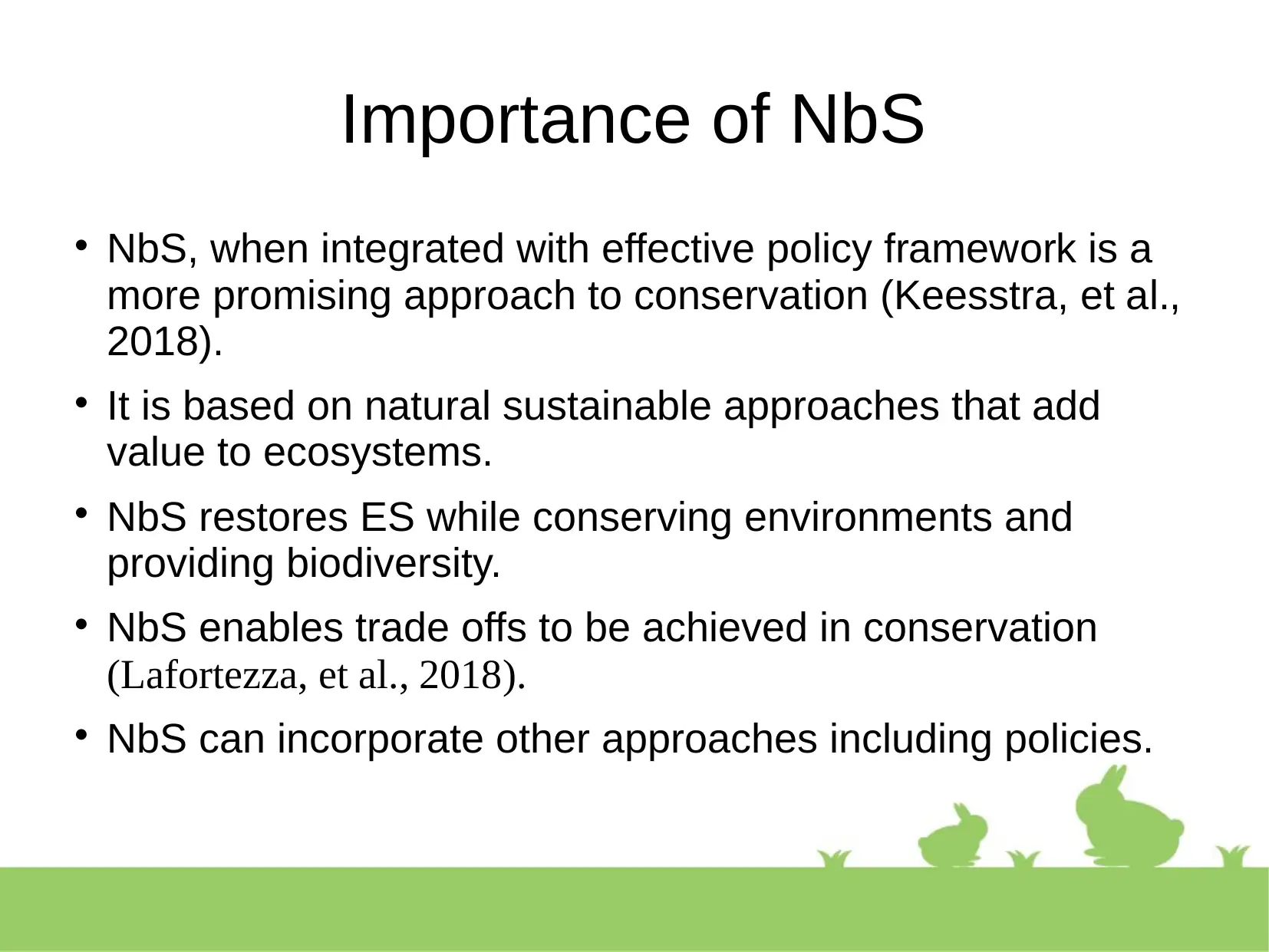
Importance of NbS
NbS, when integrated with effective policy framework is a
more promising approach to conservation (Keesstra, et al.,
2018).
It is based on natural sustainable approaches that add
value to ecosystems.
NbS restores ES while conserving environments and
providing biodiversity.
NbS enables trade offs to be achieved in conservation
(Lafortezza, et al., 2018).
NbS can incorporate other approaches including policies.
NbS, when integrated with effective policy framework is a
more promising approach to conservation (Keesstra, et al.,
2018).
It is based on natural sustainable approaches that add
value to ecosystems.
NbS restores ES while conserving environments and
providing biodiversity.
NbS enables trade offs to be achieved in conservation
(Lafortezza, et al., 2018).
NbS can incorporate other approaches including policies.
⊘ This is a preview!⊘
Do you want full access?
Subscribe today to unlock all pages.

Trusted by 1+ million students worldwide
1 out of 24
Related Documents
Your All-in-One AI-Powered Toolkit for Academic Success.
+13062052269
info@desklib.com
Available 24*7 on WhatsApp / Email
![[object Object]](/_next/static/media/star-bottom.7253800d.svg)
Unlock your academic potential
Copyright © 2020–2025 A2Z Services. All Rights Reserved. Developed and managed by ZUCOL.



